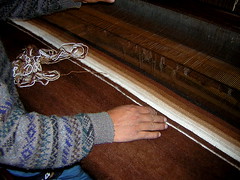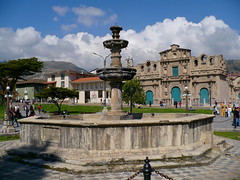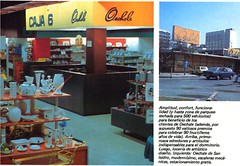Real Felipe Fortress
The Fortaleza del Real Felipe is the most prominent landmark in Callao. Built during colonial times, it was used to defend Spain’s most important port in the Americas against pirates and corsairs who would otherwise raid Callao or nearby Lima as they did up and down the Pacific coast. Today it is a tourist attraction and museum run by Peru’s army.
During the early colonial period, the Spanish, having conquered the Inca Empire, were busy shipping off its treasures to Spain. Granted license as the continent’s principle port, El Callao was where most of the seized riches were shipped from. This, combined with the fact that Lima was slowly becoming the wealthiest city in the Empire and hence the world, made it a prime target for pirate raids. To protect their port, viceroy Pedro Álvarez de Toledo y Leiva ordered the construction of a wall around the city in the 1640s. This served well, but was unfortunately destroyed by a tsunami in 1746. Viceroy José Antonio Manso de Velasco afterwards ordered the construction of a fortress.
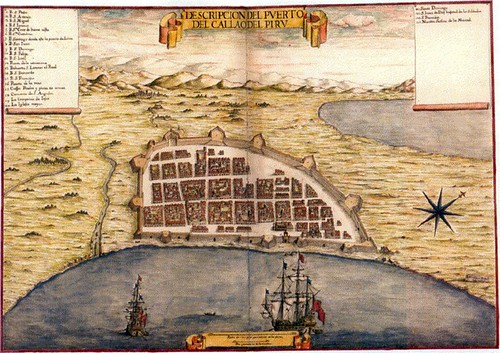
Callao in the late 1600s, early 1700s
A French architect by the name of Luis Godin had his fort design chosen and on the 21st of January 1746 work began on digging the ditches. The first stone was laid on the 1st of August 1747.
The Real Felipe fortress was one of the largest construction projects the Spanish had every undertaken costing a bank-breaking 3 million pesos. Many blocks were cut from the San Lorenzo island off the coast, while others were removed from the destroyed remains of the old Callao wall. The fortress was named after Felipe V of Spain of the House of Borbón who had recently died.
Work was finally completed in 1774 with two additional forts added at its flank in 1782. These became known as the Castles of Callao.
Independence
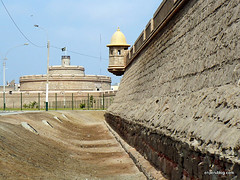
Tower
In 1806, talk of independence from Spain was first heard on the streets of Callao, Lima and other cities in the empire such as Buenos Aires. Recent events in that far off city had shown Spain to be weak and unresponsive in light of a British invasion, but Americans completely capable of defending themselves. In what was affectively the imperial capital, Lima, the viceroy José Fernando de Abascal y Sousa gave orders for weapons and ammunition to be stockpiled at Real Felipe. A wise move – just 4 years later all hell broke loose in Argentina, which led to the independence of the southern Spanish colonies and a liberation army commanded by San Martín to head straight to the Spanish centre of power – Peru.
By 1816, the war was taking place right there in Callao. Patriot admiral Guillermo Brown had blockaded Callao and captured Spanish ships. But heavy fire from Real Felipe’s cannons forced him to back off.
Real Felipe and its Spanish garrison also held off land attack led by Lord Thomas Cochrane, forcing San Martín to capture less-well defended Pisco to the south and march on Lima from there.
Peruvian independence was declared on the 28th of July 1821. The Spanish, including a number of fleeing civilians, surrounded in the fortress slowly died of starvation and scurvy. By September it was in the hands of the Patriots. The Spanish re-invaded in 1824 but were finally defeated by San Martín’s forces. The last enclave of the Spanish empire was now found at the end of the world in a similar fortress in Ancud in Chiloé, but that too was finally captured.
Republican period
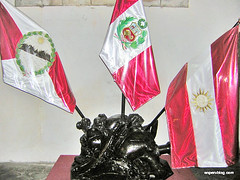
Old and current flags
During the early republican period, Real Felipe was Lima and Callao’s main line of defence against the Spanish. It was also used as a political prison. In 1834 it was used as a refuge by recently elected President Luis José Orbegoso y Moncada in light of a attempted coup by ex-President Agustín Gamarra.
In 1839 Real Felipe’s days of battles and refuge seemed to behind it when it was turned into Callao’s customs house. However, with the bloody invasion of Peru by Chile its services were called upon one last time. At the hands of the Chileans, the Castles of Callao, the two forts at the back of Real Felipe were destroyed, but Real Felipe held strong preventing and quick capture by sea of Peru’s capital.
After the war, it continued as a customs building until 1955 when it was declared by President Augusto Leguía to be a national monument. Its life as a museum had begun.
Tourism
Today the fortress can be visited by the public, included in entrance fee is a Spanish speaking tour guide. The tour lasts 2 hours and includes visits to all parts of interest including the museum of military history which includes old weapons and uniforms and the watch towers. Tours of course also include a visit to the dungeons.
Photos
Tags: 1600s, 1700s, 1800s, 1900s, callao, colonial, independence, military, museum, real felipe fortress, san martin, spaniards, war of the pacific






